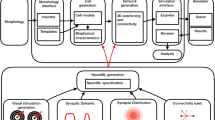Summary
A formal derivation of the optical demands of the neural superposition eye is presented. The treatment is based on a lattice description of the visual system using a H(orizontal) and V(ertical) axis.
Hence a relation for the interommatidial angles along these axes can be derived and the close connection between eye shape and facetlens pattern emerges. Possible general consequences for insect visual systems are discussed.
Similar content being viewed by others
References
Beersma, D. G. M., Stavenga, D. G., Kuiper, J. W.: Organization of visual axes in the compound eye of the flyMusca domestica L. and behavioural consequences. J. comp. Physiol.102, 305–320 (1975)
Bernard, G. D., Miller, W. H.: Interference filters in the corneas of Diptera. Invest. Ophthal.7, 416–434 (1968)
Boschek, C. B.: On the fine structure of the peripheral retina and lamina ganglionaris of the flyMusca domestica. Z. Zellforsch.118, 369–409 (1971)
Braitenberg, V.: Patterns of projection in the visual system of the fly. I. Retina-lamina projections. Exp. Brain Res.3, 271–298 (1967)
Braitenberg, V.: Ordnung und Orientierung der Elemente im Sehsystem der Fliege. Kybernetik7, 235–242 (1970)
Braitenberg, V., Strausfeld, N. J.: Principles of the mosaic organization in the visual system's neuropil ofMusca domestica L. In: Handbook of sensory physiology, vol. VII/3a (R. Jung, ed.), p. 631–660. Berlin-Heidelberg-New York: Springer 1973
Franceschini, N.: Sampling of the visual environment by the compound eye of the fly: Fundamentals and applications. In: Photoreceptor optics (A. W. Snyder and R. Menzel, eds.), p. 98–125. Berlin-Heidelberg-New York: Springer 1975
Franceschini, N., Kirschfeld, K.: Étude optique in vivo des éléments photorécepteurs dans l'œil composé deDrosophila. Kybernetik8, 1–13 (1971a)
Franceschini, N., Kirschfeld, K.: Les phénomènes de pseudopupille dans l'œil composé deDrosophila. Kybernetik9, 159–182 (1971b)
Gemperlein, R.: Grundlagen zur genauen Beschreibung von Komplexaugen. Z. vergl. Physiol.65, 428–444 (1969)
Kirschfeld, K.: Das anatomische und das physiologische Sehfeld der Ommatidien im Komplexauge vonMusca. Kybernetik2, 249–257 (1965)
Kirschfeld, K.: Aufnahme und Verarbeitung optischer Daten im Komplexauge von Insekten. Naturwissenschaften58, 201–209 (1971)
Kirschfeld, K.: Optomotorische Reaktionen der Biene auf bewegte „Polarisationsmuster”. Z. Naturforsch.28c, 329–338 (1973)
Kirschfeld, K., Franceschini, N.: Optische Eigenschaften der Ommatidien im Komplexauge vonMusca. Kybernetik5, 47–52 (1968)
Kittel, C.: Introduction to solid state physics. New York-London-Sydney: John Wiley and Sons, Inc. 1968
Stavenga, D. G.: Optical qualities of the fly eye—An approach from the side of geometrical, physical and waveguide optics. In: Photoreceptor optics (A. W. Snyder and R. Menzel, eds.), p. 126–144. Berlin-Heidelberg-New York: Springer 1975
Stavenga, D. G., Beersma, D. G. M.: Formalism for the neural network of visual systems. Biol. Cybernetics19, 75–81 (1975)
Trujillo-Cenóz, O.: The structural organization of the compound eye in insects. In: Handbook of sensory physiology, vol. VII/2 (M. G. P. Fuortes, ed.), p. 5–62. Berlin-Heidelberg-New York: Springer 1972
Trujillo-Cenóz, O., Bernard, G. D.: Some aspects of the retinal organization ofSympycnus lineatus Loew (Diptera, Dolichopodidae). J. Ultrastruct. Res.38, 149–160 (1972)
Waterman, T., Horch, K. W.: Mechanism of polarized light perception. Science154, 467–475 (1966)
Author information
Authors and Affiliations
Additional information
The collaboration of Prof. Dr. J. W. Kuiper and D. G. M. Beersma is gratefully acknowledged. Dr. J. T. Leutscher-Hazelhoff made many efforts to cut down the errors in the English grammar. Miss H. E. Deenen put the finishing touch.
Rights and permissions
About this article
Cite this article
Stavenga, D.G. The neural superposition eye and its optical demands. J. Comp. Physiol. 102, 297–304 (1975). https://doi.org/10.1007/BF01464342
Received:
Issue Date:
DOI: https://doi.org/10.1007/BF01464342




